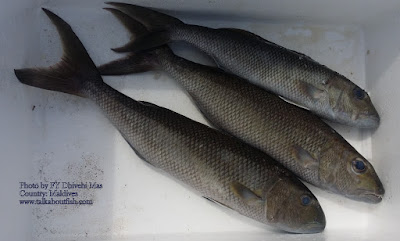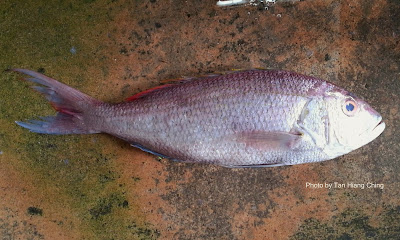Snappers (Etelinae)
Snappers or jobfishes are found in tropical and subtropical waters of all oceans. They are excellent food fish. Some species of snappers can grow to about a meter in length. They are predatory fish with sharp, conical teeth and often with canine teeth. Snappers get their name from their tendency to snap or bite swiftly at food. Most of snappers will run with the food before eating it.
Most snappers form large schools that swim close to the bottom over reef or rocky ground. Certain species of snapper sometimes foray into freshwater in search of food. Snapper commonly feeds on fishes, crustaceans and molluscs, particularly squids. Some species also eat plankton.
There are about 110 species of snappers that make up the Lutjanidae family worldwide. The Lutjanidae family are further break down into 4 subfamily which are the Lutjaninae, Etelinae, Apsilinae and Paradicichthyinae. There are 77 species under Lutjaninae which are the typical snappers, 19 species under Etelinae that are sometimes referred to as jobfishes, 12 species under Apsilinae that have a close resemblance to the fusiliers and 2 species under Paradicichthyinae that have long anterior dorsal soft ray.
Malaysia is represented by 10 genera and about 49 species of snappers. There are 33 species under Lutjaninae, 11 species under Etelinae, 3 species under Apsilinae and 2 species under Paradicichthyinae. This page only shows the Etelinae. They are distinguished from other Lutjanidae by their forked caudal fin and a close resemblance to the breams.
Most snappers form large schools that swim close to the bottom over reef or rocky ground. Certain species of snapper sometimes foray into freshwater in search of food. Snapper commonly feeds on fishes, crustaceans and molluscs, particularly squids. Some species also eat plankton.
There are about 110 species of snappers that make up the Lutjanidae family worldwide. The Lutjanidae family are further break down into 4 subfamily which are the Lutjaninae, Etelinae, Apsilinae and Paradicichthyinae. There are 77 species under Lutjaninae which are the typical snappers, 19 species under Etelinae that are sometimes referred to as jobfishes, 12 species under Apsilinae that have a close resemblance to the fusiliers and 2 species under Paradicichthyinae that have long anterior dorsal soft ray.
Malaysia is represented by 10 genera and about 49 species of snappers. There are 33 species under Lutjaninae, 11 species under Etelinae, 3 species under Apsilinae and 2 species under Paradicichthyinae. This page only shows the Etelinae. They are distinguished from other Lutjanidae by their forked caudal fin and a close resemblance to the breams.
Scientific Name: Aprion virescens Valenciennes, 1830
English Name: Green Jobfish
Chinese Name | 鱼类中文名: 绿短鳍笛鲷 (Lǜ duǎn qí dí diāo), 嘉乐 (Jiā lè)
Malay Name | Nama Melayu Malaysia: Kerisi Bali, Kerisi Basi, Guntur Hijau
Bahasa Indonesia: Ikan Guntur, Kurisi Hijau
Thai Name | ชื่อสามัญภาษาไทย: ปลากะพงเขียว (Plā kaphng k̄heīyw)
Local Hokkien: Ka Lak
Main Identification Features: A very distinct horizontal groove present on snout in front of eye and below nostrils. Forked caudal fin. Pectoral fin shorter than pelvic fin. Body dark green, bluish, or grey-blue.
Size: Maximum standard length about 80 cm, commonly to 50 cm.
Habitat and Ecology: Coral and rocky reefs, to 180 m depth. Usually solitary, sometimes in groups. Feeds mainly on fishes, but also on shrimps, crabs, cephalopods and planktonic organisms.

Scientific Name: Etelis carbunculus Cuvier, 1828
English Name: Ruby Snapper, Deep-water Red Snapper, Short-tailed Red Snapper, Queen Snapper
Chinese Name | 鱼类中文名: 红钻鱼 (Hóng zuān yú), 滨鲷 (Bīn diāo)
Malay Name | Nama Melayu Malaysia: Kerisi Bali, Kerisi Basi, Kerisi-basi Delima
Bahasa Indonesia: Ikan Bagong, Saramia
Thai Name | ชื่อสามัญภาษาไทย: ปลาสีทอง (Plā s̄ī thong), ปลากะพงทับทิม (Plā kaphng thạbthim)
Main Identification Features: Moderately elongate with shallowly forked caudal fin. Dorsal fin deeply notched. Body colour red above and pinkish to white below. Distinct yellowish lateral line. Margins of the dorsal and caudal fins are red while the tip of the lower lobe of the caudal fin is white. Outer margin of operculum pointed.
Size: Maximum fork length 127 cm, commonly to 65 cm total length.
Habitat and Ecology: Rocky reefs, 90 to 400 m depth. Occurs in aggregations. Feeds on fishes and larger invertebrates such as squids, shrimps, and crabs. It also feeds on planktonic organisms.

Click button below to see more species info and photo.
More
Scientific Name: Pristipomoides filamentosus (Valenciennes, 1830)
English Name: Crimson Snapper, Opakapaka, Crimson Jobfish, Rosy Jobfish
Chinese Name | 鱼类中文名: 蓝纹紫鱼 (Lán wén zǐ yú),嘉乐 (Jiā lè)
Malay Name | Nama Melayu Malaysia: Ikan Kerisi Batu, Ibu Kerisi, Kerisi Bali Filamen
Bahasa Indonesia: Kurisi Bali, Tola, Opaka
Thai Name | ชื่อสามัญภาษาไทย: ปลาสีเงินใหญ (Plā s̄ī ngein h̄ıyo), ปลาสีเงินดำ (Plā s̄ī ngein dả)
Local Hokkien: Ka Lak, Angkoli
Main Identification Features: Eye relatively small, lower eye margin higher or same level with upper lip. Dorsal and caudal fins with crimson to reddish margin. Top of head with yellow lines and blue spots. Pectoral fin yellowish.
Size: Maximum total length 100 cm, commonly to about 60 cm.
Habitat and Ecology: Rocky reefs, 40 to 360 m depth, usually at 180 and 270 m depth. Feeds on small fishes, shrimps, crabs, amphipods, ascidians and salps. Migrate vertically to the upper part of its habitat to feed at night.

Scientific Name: Pristipomoides multidens (Day, 1871)
English Name: Goldbanded Jobfish, Day's Jobfish
Chinese Name | 鱼类中文名: 多牙紫鱼 (Duō yá zǐ yú), 黄吻姬鲷 (Huángwěnjī diāo), 嘉乐 (Jiā lè)
Malay Name | Nama Melayu Malaysia: Ikan Kerisi Bali, Ibu Kerisi
Bahasa Indonesia: Anggoli Putih, Kurisi
Thai Name | ชื่อสามัญภาษาไทย: ปลาสีทอง (Plā s̄ī thong), ปลาสีเงิน (Plā s̄ī ngein)
Local Hokkien: Peh La, Ka Lak, Angkoli
Main Identification Features: Body and fins yellowish to rosy in colour, with about 6 broken golden stripes on sides. Dorsal fin with pale-bluish and yellowish spots. Side of snout and cheek with 2 golden stripes bordered with blue. Top of head with a series of chevron-shaped yellow bands.
Size: Maximum standard length more than 70 cm, commonly to 40 cm.
Habitat and Ecology: Rocky reefs, 40–360 m depth, usually 125 to 275 m depth. Its a schooling species. Feeds on fishes, shrimps, crabs, lobsters, stomatopods, squids, gastropods and urochordates.

English Name: Green Jobfish
Chinese Name | 鱼类中文名: 绿短鳍笛鲷 (Lǜ duǎn qí dí diāo), 嘉乐 (Jiā lè)
Malay Name | Nama Melayu Malaysia: Kerisi Bali, Kerisi Basi, Guntur Hijau
Bahasa Indonesia: Ikan Guntur, Kurisi Hijau
Thai Name | ชื่อสามัญภาษาไทย: ปลากะพงเขียว (Plā kaphng k̄heīyw)
Local Hokkien: Ka Lak
Main Identification Features: A very distinct horizontal groove present on snout in front of eye and below nostrils. Forked caudal fin. Pectoral fin shorter than pelvic fin. Body dark green, bluish, or grey-blue.
Size: Maximum standard length about 80 cm, commonly to 50 cm.
Habitat and Ecology: Coral and rocky reefs, to 180 m depth. Usually solitary, sometimes in groups. Feeds mainly on fishes, but also on shrimps, crabs, cephalopods and planktonic organisms.

Scientific Name: Etelis carbunculus Cuvier, 1828
English Name: Ruby Snapper, Deep-water Red Snapper, Short-tailed Red Snapper, Queen Snapper
Chinese Name | 鱼类中文名: 红钻鱼 (Hóng zuān yú), 滨鲷 (Bīn diāo)
Malay Name | Nama Melayu Malaysia: Kerisi Bali, Kerisi Basi, Kerisi-basi Delima
Bahasa Indonesia: Ikan Bagong, Saramia
Thai Name | ชื่อสามัญภาษาไทย: ปลาสีทอง (Plā s̄ī thong), ปลากะพงทับทิม (Plā kaphng thạbthim)
Main Identification Features: Moderately elongate with shallowly forked caudal fin. Dorsal fin deeply notched. Body colour red above and pinkish to white below. Distinct yellowish lateral line. Margins of the dorsal and caudal fins are red while the tip of the lower lobe of the caudal fin is white. Outer margin of operculum pointed.
Size: Maximum fork length 127 cm, commonly to 65 cm total length.
Habitat and Ecology: Rocky reefs, 90 to 400 m depth. Occurs in aggregations. Feeds on fishes and larger invertebrates such as squids, shrimps, and crabs. It also feeds on planktonic organisms.
Click button below to see more species info and photo.
More
Scientific Name: Pristipomoides filamentosus (Valenciennes, 1830)
English Name: Crimson Snapper, Opakapaka, Crimson Jobfish, Rosy Jobfish
Chinese Name | 鱼类中文名: 蓝纹紫鱼 (Lán wén zǐ yú),嘉乐 (Jiā lè)
Malay Name | Nama Melayu Malaysia: Ikan Kerisi Batu, Ibu Kerisi, Kerisi Bali Filamen
Bahasa Indonesia: Kurisi Bali, Tola, Opaka
Thai Name | ชื่อสามัญภาษาไทย: ปลาสีเงินใหญ (Plā s̄ī ngein h̄ıyo), ปลาสีเงินดำ (Plā s̄ī ngein dả)
Local Hokkien: Ka Lak, Angkoli
Main Identification Features: Eye relatively small, lower eye margin higher or same level with upper lip. Dorsal and caudal fins with crimson to reddish margin. Top of head with yellow lines and blue spots. Pectoral fin yellowish.
Size: Maximum total length 100 cm, commonly to about 60 cm.
Habitat and Ecology: Rocky reefs, 40 to 360 m depth, usually at 180 and 270 m depth. Feeds on small fishes, shrimps, crabs, amphipods, ascidians and salps. Migrate vertically to the upper part of its habitat to feed at night.

Scientific Name: Pristipomoides multidens (Day, 1871)
English Name: Goldbanded Jobfish, Day's Jobfish
Chinese Name | 鱼类中文名: 多牙紫鱼 (Duō yá zǐ yú), 黄吻姬鲷 (Huángwěnjī diāo), 嘉乐 (Jiā lè)
Malay Name | Nama Melayu Malaysia: Ikan Kerisi Bali, Ibu Kerisi
Bahasa Indonesia: Anggoli Putih, Kurisi
Thai Name | ชื่อสามัญภาษาไทย: ปลาสีทอง (Plā s̄ī thong), ปลาสีเงิน (Plā s̄ī ngein)
Local Hokkien: Peh La, Ka Lak, Angkoli
Main Identification Features: Body and fins yellowish to rosy in colour, with about 6 broken golden stripes on sides. Dorsal fin with pale-bluish and yellowish spots. Side of snout and cheek with 2 golden stripes bordered with blue. Top of head with a series of chevron-shaped yellow bands.
Size: Maximum standard length more than 70 cm, commonly to 40 cm.
Habitat and Ecology: Rocky reefs, 40–360 m depth, usually 125 to 275 m depth. Its a schooling species. Feeds on fishes, shrimps, crabs, lobsters, stomatopods, squids, gastropods and urochordates.
